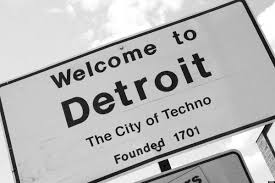
Detroit Techno Arists
In the textbook, there were a few key names mention in the Detroit Techno chapter: Ken Collier Deep Space Direct Drive/Juan Atkins Electrifying Mojo Derrick

As a student in Dr. Johnson’s Survey of African American Music class, I was tasked to research an artist of my choice and write a research paper with what i’d found. But, as a free-thinking student in general, I went a step further. My artist is Chance the Rapper, a popular artist on today’s music scene. However, there hasn’t been much, if any, research done including him, his music, his style, etc. So, I decided to use interviews and other credible music sources to conduct my own research on Chance the Rapper, his impact, and the way that he’s defied the odds as an independent artist.

Imagine hearing the same thing every time you listened to music. Your mind would go crazy and you would probably stop listening to music for a while, especially if it was your favorite artist that continued to release music that had the same sound. This is exactly what has been happening to hip hop fans for the past couple years; a lot of music began to have the same sound, with nothing to differentiate between different artists and the music they were making. This happened as a result of people trying to follow popular trends in music that they knew would allow them to build their fan base and make money, but not adding anything more than their name that would separate them from the pack. However, while these artists were focused on achieving success by following the footsteps of others, there were also artists on the other end who weren’t just concerned with quick money and fast success. One of these artists was Chance the Rapper, a young rapper from Chicago. Unlike many artists that are starting out, Chance didn’t sign to a label and, after gaining popularity, decided to remain an independent artist. Chance the Rapper’s individuality and drive to remain true to himself and the goals he’d set for his own success have allowed him to become very successful, despite the odds stacked against him as an independent artist.
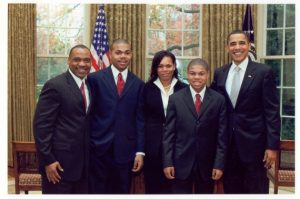
Chancelor Johnathan Bennett was born on April 16, 1993 to Ken Williams-Bennett and Lisa Bennett in Chicago, Illinois. He became an older brother at the age of 3 when the family welcomed his younger brother, Taylor, into the world. Chance grew up listening to the jazz and gospel music that his parents played, so his love for hip-hop didn’t come from direct parental influence. But, he definitely grew up with a love for hip-hop, amplified after listening to his first hip-hop album, The College Dropout by Kanye West. Hearing this album truly inspired Chance the Rapper, who said that after getting this album is when he found out he wanted to be a rapper.[1] After this, Chance really began to develop his craft, forming a hip-hop duo, called Instrumentality, with his friend J-Emcee during his freshman year of high school. They released a few mixtapes including Good Enough and Back to School Pack. But, it wasn’t until he was suspended during his senior year that he released his own project.
[1]Chance the Rapper. Chance the Rapper Drops Acid. By John Taylor. Interview Magazine, April 30, 2013.
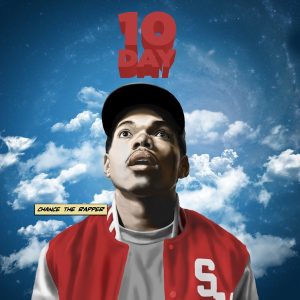
During a ten-day suspension during his senior year of high school, Chance the Rapper recorded his first mixtape as the solo artist Chance the Rapper, not the young rapper from the Instrumentality duo. He released 10 Day on April 3, 2012 as a free download on a popular mixtape website called DatPiff. The 52-minute, 14-track mixtape was very successful on DatPiff, receiving over 600,000 streams and 400,000 downloads on this site and an additional 235,000 downloads on another mixtape website called MixtapeMonkey. The mixtape received even more recognition when Forbes magazine featured it in their “Cheap Tunes” section on April 11, 2012 calling the work “atypical.”[1] This mixtape is important because, like most artists starting out in the underground community, this work was a pure expression of Chance’s artistry, being almost completely written by him, excluding the two that featured other artists. 10 Day can be considered the genesis of Chance the Rapper because it was the first look at him as a complete artist that the world had. He’d already generated a buzz before releasing 10 Day because of the performances that he’d done around Chicago, already attending meetings with record labels and even being called one of the “10 New Chicago Rappers to Watch Out For” by Complex magazine.[2] According to Complex, Chance had “one of the more distinct flows and voices of any new artist in the game.”3 Here, it’s evident that Chance’s uniqueness stood out early on in his career. But, despite the success of this album and positive light that was already being shed on him, his next mixtape really boosted him up.
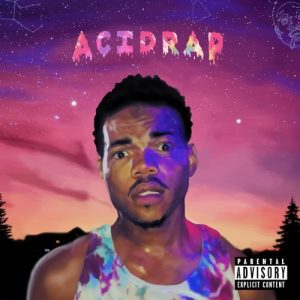
Chance didn’t waste much time after the release of 10 Day before he began working on his second mixtape, Acid Rap. This mixtape was released on April 30, 2013 as another free mixtape online. For this mixtape, Chance showed a bit of his versatility, not just using one, but incorporating various sounds/styles and creating another work that had a different sound from what people were used to hearing. He even included features from more popular artists including BJ the Chicago Kid, Twista, and Childish Gambino. Much like 10 Day, Acid Rap was extremely successful on DatPiff, acquiring “diamond” certification on the website for having over one million downloads. The mixtape also gained very positive recognition outside of the DatPiff community, being nominated for the Best Mixtape at the 2013 BET Hip Hop Awards[1], being featured as one of Pitchfork[2], Rolling Stone[3] and SPIN magazine’s “50 Best Albums of 2013”[4], and being the most downloaded mixtape on MixtapeMonkey. Despite the promising success that surrounded this mixtape, it also came with a wake-up call for the young rapper who had to come face-to-face with the reality of being an independent artist. As previously stated, Chance released this mixtape online for free. However, the mixtape somehow landed the 63rd spot on Billboard’s “Top R&B/Hip-Hop Albums” chart. This happened because outside companies noticed the mixtape’s popularity and decided to capitalize on it. The intentionally free mixtape appeared on two of the most popular musical platforms, iTunes and Amazon, for sale and was also being sold on Amazon in a physical version of the mixtape. Neither Chance nor his team were notified or asked about this before it was done, and neither were benefitting from it. Sadly, this is the reality of an independent artist; they’re not protected by the RIAA and “few checks and balances exist to prevent the work of an unsigned artist from being infringed.”[5] Despite the unfortunate and unfair nature of these acts, they also translated into something very positive: Chance the Rapper and his music were popular enough for companies to use their own resources to distribute his music and that “there’s a strong appetite for Chance in the marketplace”.8
[1] Russel, Alex. “Here Are the BET Award Nominees” Complex Magazine. August 22, 2013
[2] Pitchfork Staff. “The Top 50 Albums of 2013” Pitchfork. December 18, 2013
[3] Rolling Stone Staff. “50 Best Albums of 2013” Rolling Stone December 2,2013
[4] SPIN Staff. “SPIN’s 50 Best Albums of 2013” SPIN. December 2, 2013
[5] Ugwu, Reggie. “Chance the Rapper, with ‘Acid Rap’ Mixtape, Meets the Legal Black Hole Around Unsigned Artists (From the Magazine)” Billboard. August 14, 2013
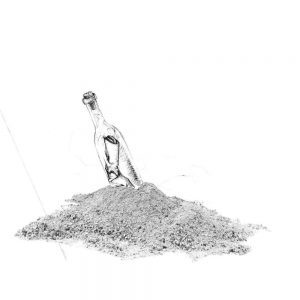
Chance satisfied this appetite with the release of Surf, a project he released as a member of a group called the Social Experiment. Chance’s unique style, versatility, and growing popularity again caught the attention of record labels, but this time it was the major labels who were hoping to capture the artist. But, despite the monetary incentives and knowing that his job as an artist might be a little easier if he did sign to a label, Chance kept his eyes on the vision that he has for his music and didn’t sign with any labels. So, Surf joined 10 Day and Acid Rap as a free project, with the only difference being that it was exclusively released on iTunes on May 28,2015. Although this project didn’t come solely from Chance the Rapper as a solo artist, his influence is very evident, from his vocals to his arrangements. The project included elements of jazz fusion, neo-soul, and other musical genres and included features from other popular artists like B.o.B., Busta Rhymes, Quavo, and Erykah Badu. The project wasn’t what fans expected from Chance, but it was widely accepted and praised, gaining a spot on numerous “Best Albums of 2015” lists including those of Pitchfork and Stereogum.
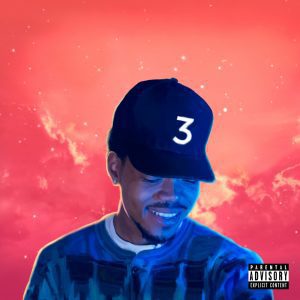
Following Surf, Chance released his third mixtape, Coloring Book, on May 13, 2016. This mixtape was different from Chance’s previous works because this was a work that he produced after moving from L.A. back to Chicago and, essentially, finding himself again. The journey and finding of his faith and the growth of a Christian child into a Christian man[1] can be heard throughout the album laced with elements of gospel and soul. This very personal project included, in true Chance fashion, different sounds and included his versatility as an artist. But, it also includes aggressive elements in a playful and relatable fashion, with songs like “No Problem” featuring 2 Chainz and Lil Wayne. Coloring Book was not only a staple for Chance, becoming the inspiration behind his merchandise, but it also made musical history as the first streaming-only album ever to be listed on the Billboard 200 and to also win a Grammy. But, Chance didn’t just win one Grammy because of this mixtape, but he won three: Best New Artist, Best Rap Album, and Best Rap Performance.[2]

Of course, his artistic success is something to be proud of and many artists would be content with just their names having as much positive recognition tied to it as Chance the Rapper’s does, but Chance has proven that his personal views on individualism and the way that he continues to create his own path for himself goes farther than just the music. His presence as a public figure is well-known, with a fan-made campaign and petition called “Chano4Mayor” and articles like “Chance the Rapper for President?”[1] being spread because Chance understands the pedestal that he’s been given as a successful artist is one that can be used to create a change, especially in Chicago. He’s also learned, after his own failed attempt, that this pedestal is one he’ll have to use to do more than just talk to the right people; he’ll have to use this pedestal to do things on his own. In August of this year, Chance met with a representative from Illinois to discuss the cuts to school funding that had been announced. However, the rapper walked away from this meeting with nothing more than disappointment and a desire to make a stand on his own. Soon after, he donated $1 million to the Chicago Public School system and urged others to donate as well.[2] He is also known for his support of Hillary Clinton’s campaign against Donald Trump. Chance explains his involvement in the community with statements like, “I come from a family of organizers and abolitionists and social workers and just a long line of people who work in the community. So, it always felt integral to me in terms of becoming a man to be a person of the people…”[3] Chance gives back to the community by doing more than becoming involved with politics, though. As an artist that started out at the open mic nights of the Chicago Public Library, he began hosting a monthly “Open Mike” night for high school students. While this may not seem like a big thing, it has allowed him to be in direct contact with some of the people who need him the most and for him to have a direct impact on a life. One of the young ladies that participate in this open mic night even commented that “Chance’s story is inspiring to me because I’m in the same types of programming he was into. So, it kind of makes me feel like I have a shot of doing something as big as he’s doing.”13
[1]Jamison, Shantell E. “June Cover Issue Exclusive: Chance the Rapper for President?” EBONY Magazine. May 26, 2017
[2] Andone, Dakin. “Chance the Rapper donates $1 million to Chicago Public Schools” CNN August 16, 2017
[3] Chance the Rapper. Chance the Rapper LIVE Interview on GMA. By Robin Roberts. Good Morning America. August 15, 2016.
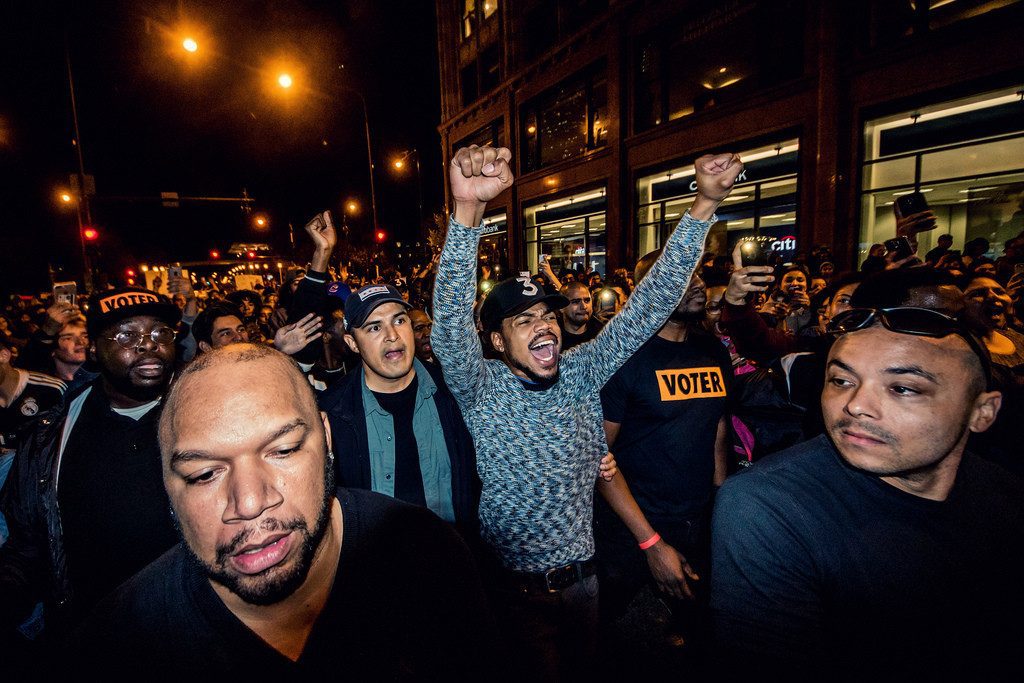
Chance the Rapper has become a game-changer in both the music industry and his community. He injected his sound and versatility into his music, exposing his fan base to an addiction that only he can satisfy with the eclectic sounds of his music. But, his music posed as the gateway drug because his actions as a person, aside from the music, are what keep people drawn to him as a person and an artist. Even before the beginning of his career, Chance was led by his own dreams and desires to remain true to what he wants for himself and his music. Following this without the pressures from outside sources like record labels, for example, have allowed him to essentially do whatever he wants. His ability to remain true to himself despite everything that’s been thrown at him has allowed him to make the best decisions for himself and these decisions have propelled him through the music industry. He has become a household name for today’s generation, a world leader[1], and even an inspiration for young people in the position that he started in.
Andone, Dakin. “Chance the Rapper donates $1 million to Chicago Public Schools” CNN August 16, 2017
Barber, Andrew. 10 New Chicago Rappers to Watch Out For”. Complex Magazine. Feb 23, 2012
Chance the Rapper. Chance the Rapper Drops Acid. By John Taylor. Interview Magazine, April 30, 2013.
Chance the Rapper. Chance the Rapper LIVE Interview on GMA. By Robin Roberts. Good Morning America. August 15, 2016.
Chance the Rapper. Chance the Rapper Losing God Helped Him Create Music as ‘Christian Man’. By Justin Sarachik. Rapzilla. May 26, 2016.
Fortune Staff. “World’s Greatest Leaders” Fortune April 1, 2017
Galil, Leor. “Cheap Tunes: Chance the Rapper’s ’10 Day’” Forbes. April 11, 2012.
Havens, Lyndsey. “Chance the Rapper’s ‘Coloring Book’ Is First Streaming-Only Album to Win a Grammy” Billboard February 13, 2017
Jamison, Shantell E. “June Cover Issue Exclusive: Chance the Rapper for President?” EBONY Magazine. May 26, 2017
Pitchfork Staff. “The Top 50 Albums of 2013” Pitchfork. December 18, 2013
Rolling Stone Staff. “50 Best Albums of 2013” Rolling Stone. December 2,2013
Russel, Alex. “Here Are the BET Award Nominees” Complex Magazine. August 22, 2013
SPIN Staff. “SPIN’s 50 Best Albums of 2013” SPIN. December 2, 2013
Ugwu, Reggie. “Chance the Rapper, with ‘Acid Rap’ Mixtape, Meets the Legal Black Hole Around Unsigned Artists (From the Magazine)” Billboard. August 14, 2013

In the textbook, there were a few key names mention in the Detroit Techno chapter: Ken Collier Deep Space Direct Drive/Juan Atkins Electrifying Mojo Derrick
For me, the answer to this question is pretty simple, music makes all the difference. It’s no secret that Black people have had a very

Usher Raymond IV was born on October 14, 1978 in Dallas, Texas. Usher joined a singing group called NuBeginnings at the age of ten and

Ashanti Shequoiya Douglas was born on October 13, 1980 in Glen Cove, New York. Ashanti grew up taking dance lessons and singing in her church

Login to your account